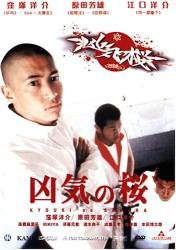Kyouki no Sakura – Madness In Bloom (Sonoda Kenji 2002)
Kyouki no Sakura
[Madness In Bloom]
Genre: Japanese Fascism Meets Clockwork Orange
review in one breath
The title Kyouki no Sakura, though translated rather simply as Madness in Bloom, is in fact a play on words. The pronounced term “kyouki” perhaps most commonly connotes “madness” (aka “dangerous spirit/mind”), but it can also mean “chivalrous spirit”. In the title of this film, the term is spelled using one character from each of these meanings, specifically using the character for chivalrous rather than madness. The term “sakura” could likewise mean “bloom” in general but here most clearly refers to the more specific cherry blossom, long beloved by Japanese as their national flower. (The flower permeates the film, most dramatically in the yakuza boss’ home.)


